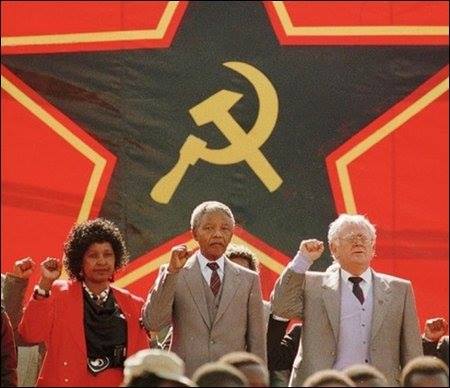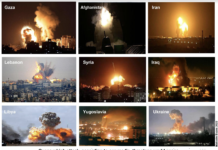I was going to write this blog on the theme of ‘Their Mandela and Ours’. Then I discovered that James Robb, an old friend, had done exactly that. He wrote:
Our Mandela is not a saint but a man – the finest kind of man, a fighter – who in his youth rejected the life of relative privilege open to him, in order to devote his life to the struggle for freedom. Our Mandela exploited all possible legal channels for advancing this struggle, yet did not flinch at pursuing illegal methods, including armed struggle, when that proved necessary.
Our Mandela pursued the struggle without letup in the face of colossal persecutions, vile slanders, and cruel isolation. He demonstrated not just in words but in deeds that he was prepared to sacrifice his own life in the struggle for freedom. He declared that South Africa belongs to all who live there, and acted on that declaration, resisting all the countervailing pressures, even a split in the movement.
James also rejected some of the criticisms of Mandela from the left for not meeting our expectations. He concluded:
The new stage of the struggle demands a new class consciousness and a new working class leadership. Such a leadership will be built as the struggle unfolds in the new conditions of post-apartheid South Africa. That was never going to be Mandela’s responsibility. We should honour our Mandela, his example and his achievements, then move on to our tasks.
I couldn’t agree more.
It’s been difficult to watch the new South Africa fail to make significant improvements to the living conditions of the country’s very poor, Black majority. The peoples’ expectations have run up against the harsh, unforgiving international capitalist order in which South Africa’s liberation goals have become ensnared.
It has been disappointing that it has taken almost 20 years for a significant new left alternative to the pro-capitalist ANC government to begin to merge since the end of apartheid registered in the 1994 election. Significant sectors of the working class movement are also discussing and debating the need for class struggle action and socialist policies for the second liberation struggle, to resist what capitalism is delivering to them.
The mainstream left in South Africa has been completely dominated by the South African Communist Party (SACP) and this has barred the route to a socialist course. This party has been riddled with a Stalinist, bureaucratic mentality and political strategy that insisted the current stage of the revolutionary process in South Africa must confine itself to building a non-racial, capitalist state
The Communist Party has played a central leadership role in both the African National Congress (ANC) and the trade union movement in South Africa. Until recently, virtually the entire national executives of all the major unions and the Congress of South African Trade Unions (COSATU), the central trade union federation, were SACP members. Top ministers in the government have been SACP leaders since the election of 1994. At that time, the Soviet Union had collapsed and the parties associated with that dictatorship often adopted more and more openly pro-capitalist positions and abandoned any pretense of representing the working class.
While in government, the Communist Party ANC ministers enjoyed huge salaries and privileges and they carried out policies that have perpetuated the poverty and inequality that exists in South Africa today. They have used and abused their union leadership roles to put a brake on the working class struggle.
We had our own examples of this in New Zealand. Ken Douglas, the former head of the pro-Moscow Socialist Unity Party and President of the Council of Trade Unions until 1999, was instrumental in preventing the success of the movement for a general strike against the anti-union laws in the early 1990s.
The adoption of the anti-union laws and the demoralising effect of the capitulation of the central union leadership contributed to a massive weakening of working class organisation and a decline of working class living standards. Since his retirement from the union movement, Ken Douglas has served on boards of NZ Post, Air New Zealand and NZ Trade and Enterprise. He is also chairperson of Positively Wellington Business and a board member of the Asia NZ Foundation.
Rob Campbell, another former SUP member, recently quit the Ports of Auckland board because it was being too soft on the workers!
In South Africa, big business began to realize in the 1980s that it could not continue ruling through the apartheid regime. International sanctions and boycotts were hurting. The anti-apartheid mobilisations of students, workers and others inside the country appeared to be heading towards a revolutionary showdown.
From that point on, big business went on an offensive to court the ANC leadership and make the transition to post-apartheid rule as painless to them as possible. In particular, they wanted the ANC to abandon its commitment to nationalising the mining and other monopolies. Part of this strategy was simple flattery and bribery.
According to Martin Plaut, the former Africa editor for BBC World Service News and author of Who Rules South Africa?, from an early stage of the transition from apartheid, “there were already plans afoot to bring the leadership of the ANC into the fold. White business magnates had begun to transfer assets into black hands in order to incorporate those at the top of the new political order. The new policy was ‘Black Economic Empowerment’ (BEE). As the commentator Moeletsi Mbeki put it: ‘BEE was, in fact, invented by South Africa’s economic oligarchs, that handful of white businessmen and their families who control the commanding heights of the country’s economy, that is mining and its associated chemical and engineering industries and finance’.”
Cyril Ramaphosa, the current deputy president of the ANC, illustrates the journey many have followed. Ramaphosa emerged to fame as the fiery leader of the National Union of Mineworkers (NUM) in the 1980s. The NUM became the largest and most powerful union in the country at that time with 300,000 members. He led the biggest strike in South Africa’s history. He then became Secretary-General of the ANC, in 1991, and helped steer the negotiations to end apartheid rule.
Today, Ramaphosa is one of the richest men in South Africa. His fortune is estimated at $675 million by Forbes magazine. His interests including gold and platinum mining, real estate, banking, insurance and telecoms.
Last year, a strike broke out in the Lonmin-owned Marikana platinum mines. Ramaphosa is a significant shareholder in Lonmin. The strike was led by a union that is independent of the ANC and the NUM. Ramaphosa denounced the strike as a “criminal act.” In one of the emails to Lonmin’s chief commercial officer, Albert Jamieson, Ramaphosa wrote: “The terrible events that have unfolded cannot be described as a labour dispute. They are plainly, dastardly criminal and must be characterised as such. There needs to be concomitant action to address this situation.” This email was sent exactly 24 hours before police fired live ammunition at the workers on strike, killing 34 and injuring 78 others.
Ramaphosa is not unique in this regard, even for NUM leaders. South African-based journalist Terry Bell writes: “The NUM provided classic examples of those who had made the transition from worker leaders to the upper echelons of big business. Former NUM general secretary, Cyril Ramaphosa, former deputy general secretary Marcel Golding and one-time NUM negotiator Irene Charnley all now have billionaire status. And former NUM president James Matlatsi seemed to move seamlessly from union boss to chair of AngloGold Ashanti.
“The fact that NUM general secretary Frans Baleni last year accepted a 108 per cent increase to take his basic pay to R77 000 a month also rankled. But throughout the mining sector, there are numerous examples of careerism within union ranks, with full time shop stewards, enjoying special privileges, becoming removed from the rank and file. A number have also taken charge of human resources departments for managements.”
An average workers wage in South Africa is R3000 per month although a miner may earn up to R5000.
The new union established in the platinum industry that organised the strikes is led by revolutionary socialists associated with the international political tendency that calls itself the Committee for a Workers International. They are also involved in the formation of the Democratic Socialist Movement in South Africa.
In 2011, the Democratic Left Front of South Africa was formed. It is described in Wikipedia as a “non-sectarian and non-authoritarian anti-capitalist front” rather than a party and includes much of the left outside the Communist Party and some of the popular struggle organisations that have emerged in the townships.
The Marikana mine massacre has even produced some soul searching among historic leaders of ANC and SACP. Ronnie Kasrils, who held various minsterial posts in the post-apartheid governments until he resigned in 2008, dropped a bombshell when he wrote this in a new introduction to his autobiography:
From 1991 to 1996 the battle for the ANC’s soul got under way, and was eventually lost to corporate power: we were entrapped by the neoliberal economy – or, as some today cry out, we “sold our people down the river”.
What I call our Faustian moment came when we took an IMF loan on the eve of our first democratic election. That loan, with strings attached that precluded a radical economic agenda, was considered a necessary evil, as were concessions to keep negotiations on track and take delivery of the promised land for our people. Doubt had come to reign supreme: we believed, wrongly, there was no other option; that we had to be cautious, since by 1991 our once powerful ally, the Soviet Union, bankrupted by the arms race, had collapsed. Inexcusably, we had lost faith in the ability of our own revolutionary masses to overcome all obstacles. Whatever the threats to isolate a radicalising South Africa, the world could not have done without our vast reserves of minerals. To lose our nerve was not necessary or inevitable. The ANC leadership needed to remain determined, united and free of corruption – and, above all, to hold on to its revolutionary will. Instead, we chickened out. The ANC leadership needed to remain true to its commitment of serving the people. This would have given it the hegemony it required not only over the entrenched capitalist class but over emergent elitists, many of whom would seek wealth through black economic empowerment, corrupt practices and selling political influence.
The National Union of Metalworkers of South Africa (NUMSA), the largest union in South Africa with close to 400,000 members, has come out in opposition to the deepening neoliberal economic policies of the South African government. It is also opposed to recent attacks on COSATU coming from the ANC and SACP leaders aimed at weakening that body’s political independence and militancy. The NUMSA was formed in 1987 through the merger of four existing unions of metalworkers and the transfer of affiliation of metalworkers who were members of two COSATU transport worker unions.
NUMSA campaigns for socialist policies and a class struggle approach to climate change and energy transition. The debate within NUMSA and COSATU includes the possible formation of a mass workers party independent of the ANC.
The working class of South Africa will yet have the last say on the future of South Africa.






I look forward to an article on the uncritical worship that the Socialist Action League gave to the ANC during the 1980s. It’s easy to slam the SUP, but the full picture would be interesting.
Thanks Mike – very interesting.
[…] capitalist order in which South Africa’s liberation goals have become ensnared. By Mike Treen, The Daily Blog (New Zealand), Dec 9, 2013 Mike Treen is a founder and director of the Unite union in New […]
[…] capitalist order in which South Africa’s liberation goals have become ensnared. By Mike Treen, The Daily Blog (New Zealand), Dec 9, 2013 Mike Treen is a founder and director of the Unite union in New Zealand. Mandela: never forget how […]
[…] capitalist order in which South Africa’s liberation goals have become ensnared.By Mike Treen, The Daily Blog (New Zealand), Dec 9, 2013Mike Treen is a founder and director of the Unite union in New […]
Comments are closed.